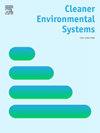Sustainable pathways for CO2 mitigation: A comparative energy, exergy, and economic analysis of optimized post-combustion capture and microalgae-based sequestration
IF 4.9
Q2 ENGINEERING, ENVIRONMENTAL
引用次数: 0
Abstract
Global warming has become one of the most pressing global challenges in recent years. In response, a range of technologies has been developed to mitigate its effects. One such approach involves burning biogas, which primarily produces carbon dioxide. The goal is to capture this CO2 to support a sustainable system. One such technology is carbon capture, particularly post-combustion carbon capture (PCC) at the industrial scale. However, conventional PCC configurations are associated with high energy consumption and inefficiencies, such as the lack of integration between the hot and cold sections. In this study, Aspen HYSYS V11 was employed to simulate and analyze three distinct PCC configurations: Lean Vapor Compression (LVC), Solvent Split Flow (SSF), and Rich Solvent Recycle (RSR). These configurations were rigorously evaluated for their energy efficiency and CO2 capture performance. Additionally, a comparative assessment was conducted between conventional PCC technologies and a bioremediation-based alternative: microalgae cultivation systems, in which CO2 is absorbed through photosynthetic microalgae growth. This comparative analysis was designed to benchmark the viability of biological carbon sequestration against solvent-driven PCC processes, providing insights into their respective technical and environmental tradeoffs. Furthermore, a comparative analysis based on energy, exergy, and economic performance was presented. In the PCC sector, the results showed that the RSR configuration could increase efficiency by approximately 3 % compared to the conventional configuration, while reducing the overall cost by about 1.30 $/h, bringing the total cost to around 23.28 $/h. When compared with the microalgae plant, the findings were even more significant. The microalgae system demonstrated a high exergy efficiency of about 72.64 % and a substantially lower total cost of approximately 7.17 $/h. These results indicate that the microalgae approach offers considerable advantages over even the optimized PCC configurations.
减缓二氧化碳的可持续途径:优化燃烧后捕集和基于微藻的封存的能源、能源和经济比较分析
近年来,全球变暖已成为最紧迫的全球性挑战之一。为此,人们开发了一系列技术来减轻其影响。其中一种方法是燃烧沼气,而沼气主要产生二氧化碳。目标是捕获这些二氧化碳,以支持一个可持续的系统。其中一项技术是碳捕获,特别是工业规模的燃烧后碳捕获(PCC)。然而,传统的PCC配置与高能耗和低效率相关,例如冷热部分之间缺乏集成。在本研究中,使用Aspen HYSYS V11模拟和分析了三种不同的PCC配置:Lean Vapor Compression (LVC), Solvent Split Flow (SSF)和Rich Solvent Recycle (RSR)。对这些结构的能源效率和二氧化碳捕获性能进行了严格的评估。此外,还对传统的PCC技术与基于生物修复的替代技术——微藻培养系统进行了比较评估,其中微藻通过光合作用吸收二氧化碳。这项比较分析旨在对生物固碳与溶剂驱动的PCC工艺的可行性进行基准测试,从而深入了解它们各自的技术和环境权衡。在此基础上,从能源、用能和经济效益三个方面进行了对比分析。在PCC领域,结果表明,与传统配置相比,RSR配置可以提高约3%的效率,同时降低约1.30美元/小时的总成本,使总成本降至23.28美元/小时左右。与微藻植物相比,这一发现更为显著。该微藻系统的火用效率高达72.64%,总成本大幅降低,约为7.17美元/小时。这些结果表明,微藻方法比优化后的PCC配置具有相当大的优势。
本文章由计算机程序翻译,如有差异,请以英文原文为准。
求助全文
约1分钟内获得全文
求助全文
来源期刊

Cleaner Environmental Systems
Environmental Science-Environmental Science (miscellaneous)
CiteScore
7.80
自引率
0.00%
发文量
32
审稿时长
52 days
 求助内容:
求助内容: 应助结果提醒方式:
应助结果提醒方式:


